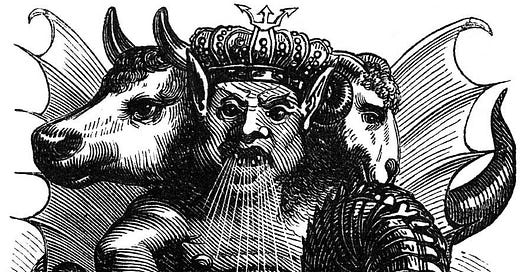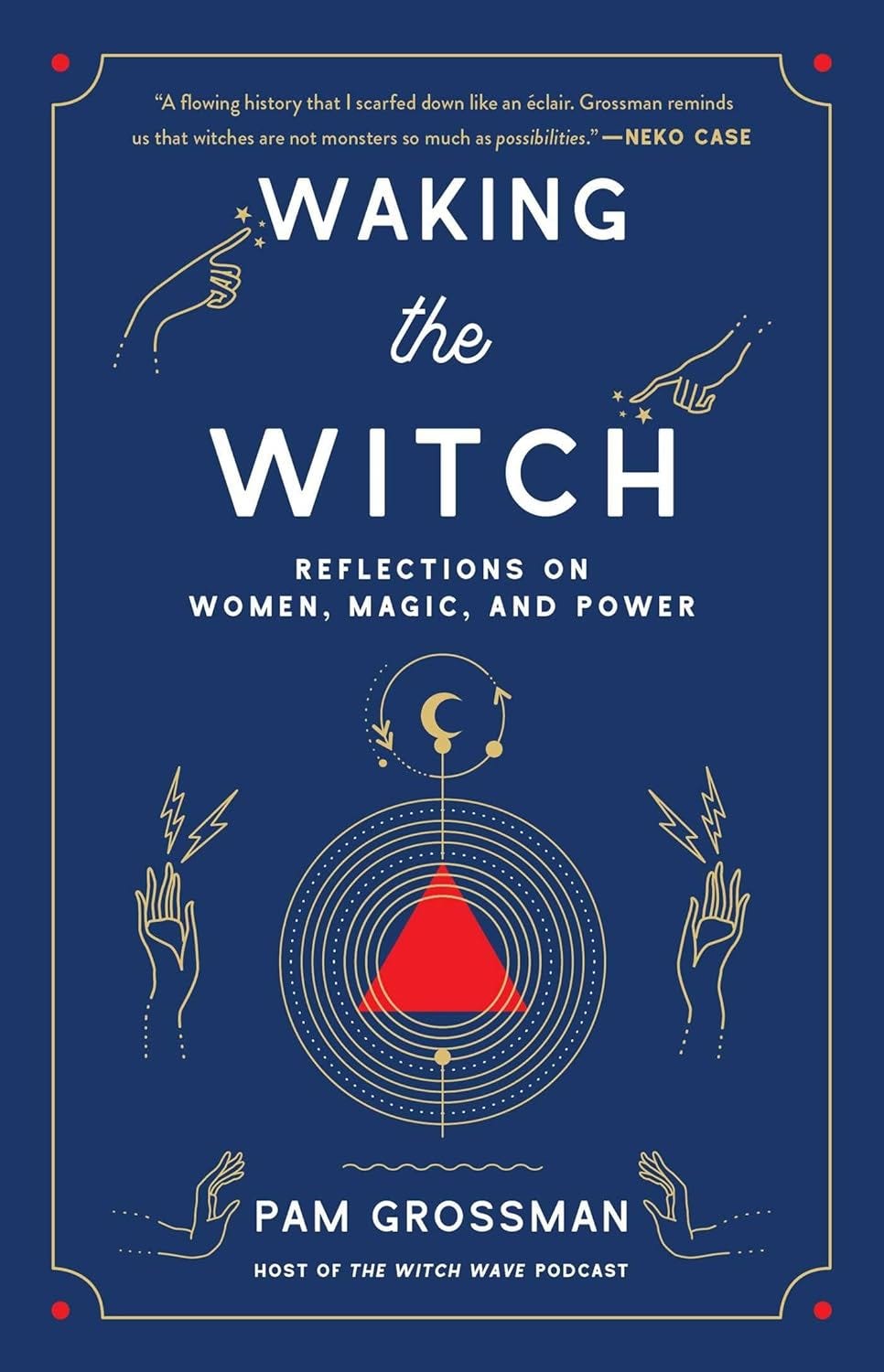Natural Secrets and Ancient Wisdom
A history of magical record keeping and use of the spell book in Sarah Beth Durst's 'The Spellshop'
Happy Spring!
Are you feeling the love, readers? How did you like our February read, The Spellshop by Sarah Beth Durst? I know, I know, I’m a bit late (again) in posting this, but research and writing take time, and I think in the future I will continue leaving a bit of room between finishing the book and writing the post. You’re fine with that, right? Great.
For me, this book felt like a deep, bone-cracking, stress-relieving, sigh-inducing hug. It made me want to smile, go about my day a little lighter, a little kinder, and look at the world with a teensy bit more hope.
The Spellshop featured so many more magical creatures than I anticipated. When the unicorn showed up, I suddenly understood why my friend described the book as “D&D vibes.” Anything goes in this world, more or less. There are mermaids, unicorns, bear-shaped forest spirits (with a strangely Fae-like ability to portal humans to Somewhere via trees), merhorses (hippocampi, a little Greek mythology wink that I appreciated), centaurs, deer-people and fish-people, sorcerers, probably anything I could name here would be likely found in this magical universe. I was just waiting for a dragon to appear.
But I wanted to spotlight something specific for this newsletter, something niche and central to the story— and what was more central to this story than the spellbooks? For this newsletter, I’m diving into the history and practice of record-keeping spells in magical books.
Fans of fantasy, dabblers in witchcraft, Wiccans, and anyone who grew up obsessed with the show Charmed may be familiar with the terms grimoire, spell book, book of shadows, and the like, but what really is the difference between these various magical manuscripts? From my research, the lines are rather blurry.
Writer Elisa Shoenberger wrote a short article to promote a 2019 event at the Brooklyn Antiquarian Book Fair, which featured William Kiesel and Pam Grossman presenting “Collecting Grimoires, Spell Books, and Witchcraft Tomes.”
—Friends, if you don’t already know who Pam Grossman is, allow this post to be your fated introduction that will send you spiraling down a rabbit hole of witchcraft and artistry. Author of Waking the Witch: Reflections on Women, Magic, and Power, and host of The Witch Wave podcast “for bewitching conversation about magic, creativity, and culture,” Pam is an incredibly inspiring and gifted writer, artist, and curator. I also hear she’s releasing a new book— Magic Maker: The Enchanted Path to Creativity (Penguin Life Oct 2025) and I will be first in line to buy.
Okay, I just had to boost Pam, now back to grimoires—
“Grimoire come from French that means ‘book of magic’ but it derives from the word ‘grammar’ so it refers to a grammar of magic,” occultist scholar William Kiesel explains. “Typically, grimoires are often manuals of practice that give recipes, operations, rituals and perhaps even spells.” Spellbooks, Kiesel says, are more associated with folk magic and practice while witchcraft tomes are more like a belief system or “what it means to be a witch.”
— “Collecting Grimoires, Spell Books, and Witchcraft Tomes” by Elisa Shoenberger
In my own passing exposure to grimoires, I’ve come to understand them as a tool that one builds for personal usage rather than a how-to guide on being the perfect version of whatever type of witch, spiritualist, or person one is trying to be.
Kiesel expresses a similar sentiment in explaining why people are drawn to grimoires:
“People want to have spiritual life, but they may be distrustful of the traditional religions. Grimoires allow you to approach it on an individual basis.”
I’ve always advocated for the individual’s freedom in how they choose to practice their religion, or any religion that resonates with their spirit. But even if you’re not spiritual, grimoires have practical applications as well.
Grimoires can also be an excellent archival tool and direct pathway to connect with one’s community, ancestors, and heritage. Durst tapped into this idea of books as ancestral heirlooms in Spellshop with Kiera’s recipe book that she inherited from her parents. Out of all the spellbooks she protected and used to better her community, I would argue it was her parents’ jam recipe that allowed Kiera to discover how exactly she could fit into that community and create a new life for herself by selling jam. Yes, the jam shop was a front for the spell shop, but she earnestly made and sold the jam, cared about how it tasted, and considered how it would benefit Bryn's bakery—benefiting her livelihood in turn.
It reminds me of my grandmother’s butter cookie recipe that my mother has kept alive by making batches of butter cookies with crystal sprinkles for every member of our family and several of my close friends every single Christmas since I was a child. She promised me that I would receive Grandma’s recipe book as part of my inheritance, and I plan on fiercely protecting it like a library spellbook because those cookies are literal magic.
“Grimoires are books that contain a mix of spells, conjurations, natural secrets and ancient wisdom. Their origins date back to the dawn of writing and their subsequent history is entwined with that of the religions of Judaism, Christianity and Islam, the development of science, the cultural influence of print, and the social impact of European colonialism.”
—Owen Davies, professor of social history at the University of Hertfordshire.
Many people might be surprised to learn that grimoires are not simply a thing of fantasy, existing only on TV or in books about witches. According to Owen Davies, an occultist author who has written extensively about the history of magic, witchcraft and ghosts, grimoires were in high circulation in the first few centuries AD, especially in the East Mediterranean.
Davies’ most recent book, Grimoires: A History of Magic Books, is a history of magic books that takes us from ancient Eygpt, through Kabbalah, Scandinavian witchcraft, 19th-century Egyptology, West African folk religion, a Chicago mail-order charlatan whose books are still banned in Jamaica today, and – of course – Buffy the Vampire Slayer.
I was very tickled when I discovered this listicle from The Guardian featuring Davies’ Top 10 Grimoires of all time— the type of article one might expect for favorite TV characters, like Top 10 On Screen Witches of All Time (which is an article I’m sure has been written before… very likely published by my employer EW).
According to Davies’ list, some of the most popular ancient grimoires were credited to King Solomon— but historians agree this is a false attribution and these books were written by an anonymous author. But the name stuck out, and Western clergymen were keen to learn from “the wisest of the wise.”
If you perused a 15th-century clergyman’s library you may find The Greater Key of Solomon, considered the “granddaddy of grimoires” by Davies, or the earlier Magical Treatise of Solomon translated from medieval Greek, or also The Lesser Key of Solomon also referred to as the Lemegeton, which is comprised of five books: the Ars Goetia, Ars Theurgia-Goetia, Ars Paulina, Ars Almadel, and Ars Notoria. In these books one could find invocations, curses, rituals, and ceremonial magic, plus detailed instructions on how to become invisible, gain someone’s favor, communicate with the spirits of the dead, or seal demons, as well as which animals to sacrifice, talismans to collect, symbols to draw in blood, and under which astrological time one should perform these magical operations. All very practical things. I wonder if any of these were in Kiera’s collection— they were looking for an invisibility spell that required a gemstone at one point.
Famously found in the Ars Goetia, the first book of the Lemegeton, is the list of the seventy-two demons and their associated sigils. Anybody who’s ever dipped into the world of esoterica and the occult will have heard of Aleister Crowley, who republished a version of this book as The Book of the Goetia of Solomon the King in 1904.

More recognizable by current audiences is the Book of Shadows, featured in my childhood favorite TV show Charmed, and several other films featured in Freeform’s “31 Nights of Halloween.” Mysterious and dark though it sounds, it is the foundational text of Wicca— a modern nature-centric pagan religion founded by Gerald Gardner in the 1940s. Gardner was a retired British civil servant, anthropologist, archaeologist, and author. According to Davies, “He claimed to have received a copy of this ancient magical text from a secret coven of witches, one of the last of a line of worshippers of an ancient fertility religion, which he and his followers believed had survived centuries of persecution by Christian authorities.”
Scandinavian folk magic may be found in a "black book" ("Svarteboken") written by a mysterious figure referred to as Cyprianus— a folkloric figure of many origins and varied identities. In some stories, Cyprianus refers to the early Christian bishop Saint Cyprian of Antioch, other times Cyprianus is a sorcerer, to some Cyprianus is a wicked Dane or Norwegian consorting with the Devil, and in one story Cyprianus is a Mexican nun.

In 18th century France, cheaply-made and widely-distributed grimoires were in fashion: first the Petit Albert and the Grand Albert both attributed to medieval philosopher Albertus Magnus who held the reputation of being a sorcerer, then later Le Dragon Rouge, which contained instructions on summoning Lucifer and is supposedly still well known today in French colonies in the Caribbean.

Another name for Le Dragon Rouge is The Grand Grimoire, which fans of the Fox TV series Sleepy Hollow might recognize from season 2, adding yet another title to the list of fantasy IPs whose Big Magic Book is a historically accurate reference.
And people still think fantasy is all made up, created out of thin air. No basis in reality at all. I have to laugh.
Readers, this has been a marvelous rabbit hole to journey down with you.
If The Spellshop was right up your alley and you’re itching for more, here are my recommendations for further reading:
In terms of D&D vibes, cozy fantasy, and fluffy romance, the first title that’s always brought up is Legends & Lattes by Travis Baldree, about an orc barbarian who trades in her sword for shots (of espresso) and opens up the first coffee shop in the city of Thune.
For another romantasy based on an island, I recommend another book that’s been patiently sitting on my TBR (and may be very soon picked up) The Honey Witch by Sydney Shields: on the Isle of Innisfree, Marigold Claude is the titular Honey Witch whom no one can fall in love with… until a certain grumpy skeptic shows up.
For more academic reading on grimoires, I must recommend Owen Davies’ Grimoires: A History of Magic Books, which shows the influence magic and magical writing has had on the cultures of the world, richly demonstrating the role they have played in the spread of Christianity, the growth of literacy, and the influence of western traditions from colonial times to the present.
And because I love it so much and I went out of my way to mention it in this post, I recommend Pam Grossman’s Waking the Witch: part cultural analysis, part memoir, this book delves deeply into why witches have intrigued us for centuries and why they’re more relevant now than ever.
Adieu!










